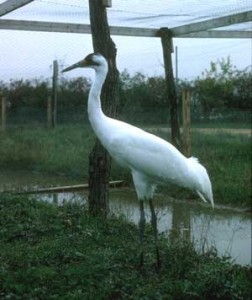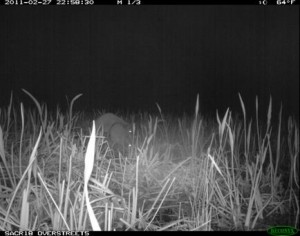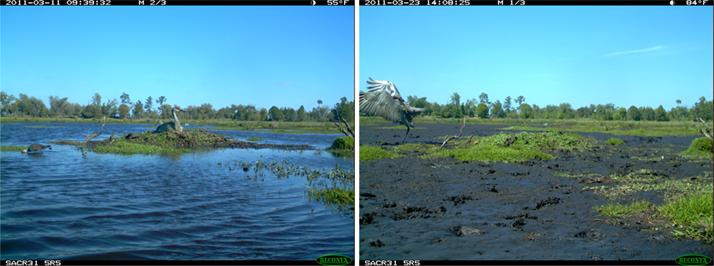Archive for the ‘Florida Updates’ Category
CANUS – 186 whooping crane descendants
February 25, 2013Editor’s note: The Whooping Crane Conservation Association (WCCA) has received several inquiries during the past year quizzing us about why we believe whooping cranes are so cherished. One person wrote “who gives a dam about whooping cranes?” Answers to questions like these are not easy when you are responding to someone who is not interested in the natural world and all its wonders. Probably the best answer was written by Aldo Leopold in “A Sand County Almanac” -“There are some who can live without wild things, and some who cannot.” To further answer the questions, I reviewed a story we printed about Canus the whooping crane in “Grus Americana” (WCCA’s newsletter) in May 2003. A more detailed article about Canus appeared on Patuxent Wildlife Research Center web page. The article is posted below to provide an example of the “value” of one whooping crane and the people who cared for him. Hopefully this article will be read by a diverse group of people including United States Attorney’s, federal judges, wildlife law enforcement personnel, wildlife biologists, news reporters and citizens interested in whooping cranes:
CANUS and his 186 whooping crane descendants (1964 – 2003)
– USGS Author unknown. Written in 2003 –
To anyone who cares about endangered species, information about their numbers is always important. For whoopers, the rarest of all cranes, the annual count has been an environmental cliff-hanger for decades. In 1938, they were down to only 18 birds in the Aransas-Wood Buffalo flock, with only 11 remaining in the non-migratory Louisiana flock. Ten years later there were 31 birds in the Aransas-Wood Buffalo flock, but the Louisiana flock was down to a single bird. By 1950, the Louisiana flock was gone. The Aransas-Wood Buffalo flock’s numbers hovered on the edge of disaster for another decade. By 1964, there were still only 42 whooping cranes in the wild.
So, when a biologist doing aerial surveys in 1964 at Wood Buffalo Provincial Park (in Saskatchewan and Northwest Territories, Canada) discovered a young-of-the-year chick with a broken wing, he quickly took action. The chick’s parents were aggressive, rushing the helicopter when it came too close. The biologist knew that the parents could keep the chick safe from predators, but soon they would have to migrate, and their chick wouldn’t be able to follow them. He wouldn’t survive long once they were gone.
The biologist contacted officials in Canada and the US, and was advised to capture the bird. They did so the next day, chasing the chick through the marshland until it tripped on its dangling primaries and fell. The young crane, once captured, offered surprisingly little resistance. An x-ray showed a 2 inch sliver of charred wood had pierced the bird’s breast muscle and his wing was partially dislocated. They speculated that he had struck a burnt tree during early flight practice. To everyone’s surprise, the young crane showed no fear of his captors and readily accepted food including smelt, mealworms, hamburger and minced eggs.
The injured chick was later transferred to Monte Vista National Wildlife Refuge, Colorado where he did well until he suddenly became ill. Four veterinarians were brought in and treated the bird, who seemed near death. Amazingly, within a day the crane seemed to recover. But his bout of bad luck wasn’t over. While exercising in his pen one morning, he caught a toe in the bandage on his injured wing and fell, breaking the wing in two places. Again, the vets repaired the wing and he again recovered. It was shortly afterward that this young crane would be given the name “Canus” — CAN for Canada and US for the United States. A leg band was attached with the number “02-64001”.
In 1966, 02-64001 was transferred to what was then the beginnings of the U.S. Fish and Wildlife Service’s endangered species captive propagation program at the Patuxent Wildlife Research Center. 02-64001 was the first whooper in the program, and would become, over his long life, the foundation sire of the captive flock. His adjustment to life in captivity was a major factor in his ability to thrive in this new environment. Unlike many wild-caught animals, he never showed fear of his caretakers, and once he matured, would be quite aggressive to them, especially during breeding season.His injured wing would eventually be amputated. Without two fully functional wings, 02-64001 could not breed naturally. And so the biologists at Patuxent developed an Artificial Insemination (AI) program so that Canus, and other whooper males who were not fully-flighted, could reproduce. With such small numbers, every individual whooper was genetically valuable. As Patuxent’s endangered species program developed, eggs from Wood Buffalo were brought here to hatch, to develop a captive breeding flock that would genetically represent the wild flock in Aransas. This captive flock would be a safeguard — a genetic back-up — in case disaster wiped out the remaining wild birds.
Those early years were devoted to building the breeding flock and learning how to propagate whooping cranes. All the while, the numbers in the wild crept up slowly but surely. In 1966, when 02-64001 came to Patuxent Wildlife Research Center, there were 43 birds in the wild. In 1976, there were 69. Meanwhile, the scientists at Patuxent were discovering just how much there was to learn about the care, feeding, and propagation of whooping cranes.
All through the growth of Patuxent’s breeding flock, the development of proper incubation techniques, the perfecting of AI, the development of health care protocols, nutritional formulas, medical techniques, and chick rearing techniques, 02-64001 was there. Because he was such a long-term subject for Patuxent’s experiments, he literally taught us much of what we know about successful husbandry and breeding of captive Whooping cranes. He sired chicks with his mate through artificial insemination, and his semen was used here on many other female whoopers. It was even shipped, cryogenically preserved, to other facilities with whooping crane females.
Over the years, Canus and his mate raised many chicks together, and were fiercely protective parents. He was surprisingly healthy, after his initial rocky start, but he did have a bout of illness during the 1980s that he recovered from, and in the last five years he had some minor problems due to arthritis in his spine. We moved a panel heater into his pen in the hopes that would help and it may have, but we never actually saw him use it. He always knew when he was being observed. At the first site of humans approaching his pen, 02-64001 and Mrs. C would start going through their threat displays, letting everyone know that if they were thinking of coming in his pen, there would be trouble!
We first wrote about 02-64001 in these reports in June, 2000. At that time, we were following the progress of a young chick destined to be released in Florida, and 02-64001 was that chick’s grandparent. We also talked about some of Canus’ offspring who were now breeding adults in our program such as 02-84003 and 02-85001, our most productive pair, and also 02-83004 and 02-83003. Last year, we reported on Lucky, the first chick to fledge to wild whooper parents in the United States in 60 years — Lucky is a great-grandchild of Canus.
Over the course of his long life, 02-64001 was responsible for 186 whoopers, as sire, grand-sire, great-grandsire and beyond. That’s four times the number of whoopers who were alive the year he was captured. His descendants today are flying free from Wisconsin to Florida and reproducing naturally in the wild in Central Florida. Today, there are nearly 420 whooping cranes in the world — ten times as many as the year he was captured. 02-64001 was no small part of that. ( Approximately 600 whoopers exist in 2013 in the wild and I captivity.)
Early in the morning of Saturday, January 18, 2003, 02-64001 was found down in his feedshed near his heater. The technicians, Barb and Brian, experienced in emergency crane care, rushed him to the veterinary hospital on Center, and after placing him in a heated pen, contacted both the veterinarian on duty, Dr. Patty Bright, and our regular veterinarian, Dr. Olsen, who was attending crane meetings in California. In a short time, 02-64001 began to rally, lifting his head, looking around, and even attempting to stand. 02-64001 was only a few weeks shy of 39 years, and had had other sudden bouts of illness, but had always recovered, so we had hopes that this would follow that pattern. Dr. Bright treated 02-64001 with injectable fluids and steroids, and consulted with Dr. Olsen about an appropriate treatment regimen for the next few days. They decided to also administer antibiotics, and continue fluids and steroids until the bird was well enough for diagnostic blood work, which might tell them more about the nature of the problem.
Unfortunately, despite Canus’ attempt to rally, he died during treatment a few hours later. It was a terrible shock to all of us. In spite of his age, 02-64001 had always fought back against the odds and had always been so strong– it was hard to imagine anything defeating him.
To the people who care about the fate of endangered species, the numbers of animals is a natural focus. How few, how many. For those of us who work with these rare animals, each individual under our care is special, unique to themselves, and valuable. In the course of our daily work, we discover their personalities, their individual quirks, and become totally involved in their welfare and that of their offspring. In many ways, 02-64001 embodied our mission — he survived against incredible obstacles, thrived, and showed a wonderful spirit and will to live. Even while we grieve his loss, we have to celebrate the success that was his life. And in the offspring he has left us, he’ll live on, both here at Patuxent, and free in the wild.
UPDATES
Lucky, the whooper who fledged this year (2003) to wild parents in central Florida (these birds are part of the non-migratory flock that lives in Florida year round), has separated from his parents and is living on his own. It’s normal for young birds to separate from their parents a few months before breeding season. Lucky is associating with wild sandhills and whoopers, and picking good habitat. He has his own radio transmitter so that the Florida biologists can keep track of him. He should be almost completely white by now. * Unfortunately, Lucky was killed by a bobcat in 2010. To see a two part video about Lucky click on: https://whoopingcrane.com/whooping-crane-videos/ Then select “Lucky the Whooping Crane” (be sure and watch both Parts 1 and 2).
After reading the article and viewing “Lucky the Whooping Crane”, we trust that you will understand why many cherish these birds.
Four Whooping Crane Flocks Thriving
April 21, 2012By: Chester McConnell, Whooping Crane Conservation Association
Western Whooping Crane Flock
“Only 5 whooping cranes remain on Aransas National Wildlife Refuge as of April 21” according to Dan Alonso, Refuge Manager. All others have begun their migration towards their nesting grounds at Wood Buffalo National Park, Canada. “Only 3 of the 29 whooping cranes carrying GPS transmitters remained on the refuge this past week” said Brad Strobel, Aransas Refuge biologist. Further north on the whooper migration route, Martha Tacha, U.S. Fish and Wildlife Service, reports that, “most of the cranes with GPS transmitters have now passed southern Nebraska and are continuing on their migration north. The cranes are currently distributed from northern Texas to northwestern Saskatchewan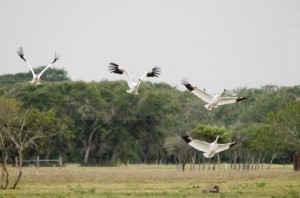 with some being within three days flying time of their Canadian nesting grounds. Some of the migrating whoopers were probably slowed last weekend due to the extensive strong storms from Oklahoma through South Dakota.”
with some being within three days flying time of their Canadian nesting grounds. Some of the migrating whoopers were probably slowed last weekend due to the extensive strong storms from Oklahoma through South Dakota.”
Further north on the migration route, wildlife technician Lea Craig-Moore, Canadian Wildlife Services reports that, “Whooping crane migration is in full swing in the Saskatchewan area.” She advised, “We have had the first flush of arrivals in the province and have birds spread from the SE prairie to the NW boreal. Family groups have been seen in a number of locations. Young cranes are learning the preferred stopover sites from their parents as they migrate.”
Eastern Whooping Crane Flock
Most of the whooping cranes in the eastern experimental flock have now reached their Wisconsin nesting area. Wisconsin Department of Natural Resources pilot Bev Paulan conducted an aerial survey April 17th and reported that there are currently 10 active nests located in the core reintroduction area in Wisconsin. Three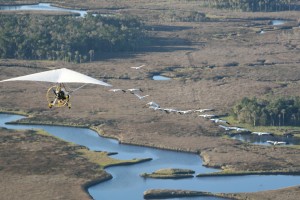 nests were abandoned earlier. Ten more pairs could possibly nest. Heather Ray, Operation Migration advises that “Hopes are high for baby chicks!”
nests were abandoned earlier. Ten more pairs could possibly nest. Heather Ray, Operation Migration advises that “Hopes are high for baby chicks!”
For several weeks, there has been much interest on the 9 young whooping cranes led south by Operation Migration ultralight planes to Alabama. Due, in part to government regulations, the young birds were finally placed on Wheeler National Wildlife Refuge in Alabama to spend the winter. On April 12 the 9 departed Alabama together on their first unaided journey north. They split into two or more groups during migration, and may be back in Wisconsin as you read this. Not quite a year old, the cranes are too young to pair up or breed. They will wander around the Wisconsin area nesting area and learn how to be whooping cranes.
Louisiana Non-Migratory Flock of Whooping Cranes
On December 1, 2011, a second cohort of juvenile whooping cranes was shipped to Louisiana from the Patuxent Wildlife Research Center. As with the first cohort, the 16 new birds (7 males, 9 females) were initially held in the top‐netted pen. Permanent bands and transmitters were attached to their legs on 8‐9 December and the birds were released into the open pen on 27 December.
On 31 December L4‐10, a survivor from the first cohort, returned to the pen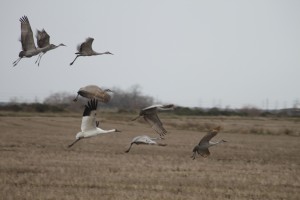 site and joined the 16 chicks. He had spent almost all summer and fall in the marsh just west of the release area and therefore had the strongest ties to the area. The 16 juveniles initially attempted to chase him away and while they continue to keep him away from the food shelter and the feeders they generally became more tolerant of his presence. Food continued to be provided for the birds in the open pen but will soon be discontinued.
site and joined the 16 chicks. He had spent almost all summer and fall in the marsh just west of the release area and therefore had the strongest ties to the area. The 16 juveniles initially attempted to chase him away and while they continue to keep him away from the food shelter and the feeders they generally became more tolerant of his presence. Food continued to be provided for the birds in the open pen but will soon be discontinued.
The young whoopers have shown a similar pattern of movement and pen use to the previous cohort – roosting outside the pen at night but using the pen during the day, primarily in the afternoons. However, with more water across the marsh this group of birds is beginning to range further away from the pen and use areas on the east side of the property which the first cohort did not use.
Florida Non-migratory Flock of Whooping Cranes
Marty Folk, Florida Fish and Wildlife Conservation Commission reports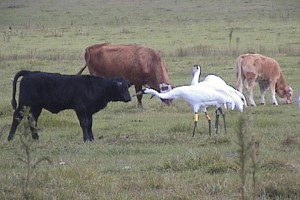 that, “As of 1 February 2012 we estimated there were 19 whooping cranes in the Florida resident population (8 males, 11 females) including 7 pairs. Again, this year, we will study the nesting ecology of these whooping cranes and Florida sandhill cranes. The goals are to determine causes of nest failure, compare the incubation behavior of the 2 species, and determine the efficacy of several research tools for these purposes. The nesting season has begun with our first sandhill crane nest just discovered in Polk County. Drought continues to plague Florida’s wetlands. The northern range of these cranes is very dry and unlikely to support much crane nesting. Fortunately, further south, we have some water for nesting.”
that, “As of 1 February 2012 we estimated there were 19 whooping cranes in the Florida resident population (8 males, 11 females) including 7 pairs. Again, this year, we will study the nesting ecology of these whooping cranes and Florida sandhill cranes. The goals are to determine causes of nest failure, compare the incubation behavior of the 2 species, and determine the efficacy of several research tools for these purposes. The nesting season has begun with our first sandhill crane nest just discovered in Polk County. Drought continues to plague Florida’s wetlands. The northern range of these cranes is very dry and unlikely to support much crane nesting. Fortunately, further south, we have some water for nesting.”
Nesting Research Conducted on Florida Cranes
August 30, 2011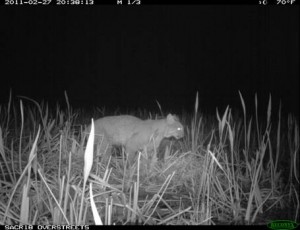 We continue to study the whooping cranes of the Florida resident flock. The flock contains 20 birds, 16 of which are paired. This spring we employed camera “traps” near nests of whooping and sandhill cranes in order to learn more about nesting issues. Camera traps, or trail-cameras as they are sometimes called, are cameras triggered by heat differential and motion. At night they use infrared “flash” to illuminate the photos. Wildlife cannot see the flash so it does not affect their behavior.
We continue to study the whooping cranes of the Florida resident flock. The flock contains 20 birds, 16 of which are paired. This spring we employed camera “traps” near nests of whooping and sandhill cranes in order to learn more about nesting issues. Camera traps, or trail-cameras as they are sometimes called, are cameras triggered by heat differential and motion. At night they use infrared “flash” to illuminate the photos. Wildlife cannot see the flash so it does not affect their behavior.
Most of our data so far are from sandhill crane nests and all results are preliminary. However, we are seeing some interesting results from the camera traps at nests. The cameras were useful for documenting 1) many occasions of visitors (representing disturbances or potential disturbances) to nests, 2) whether a nest was successful or not, 3) water levels at nests,and 4) behaviors of the birds at their nests. The following examples are presented in that order.
Camera traps successfullydocumented many disturbances or potential disturbances at nests. For one nest,the last image of the attending crane was when it flushed from the nest in the dark; and then a bobcat (Lynx rufus) walked by the nest.
While the nest was unattended, raccoons (Procyonlotor) came and scavenged the nest.
Raccoons were common near nests; at one nest they triggered the camera daily. Coyotes (Canis latrans) and an alligator (Alligator mississippiensis) also were photographed.
Sandhillcranes defended their nests from curious livestock, even when it meant dealing with an animal that weighed 200 times more than the crane.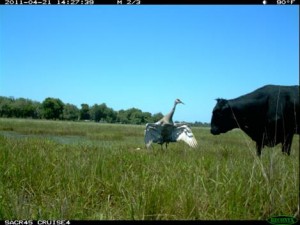
Camera traps also successfully documented whether nests hatched. Camera placement in relation to the nests provided clear views of chicks when they hatched.
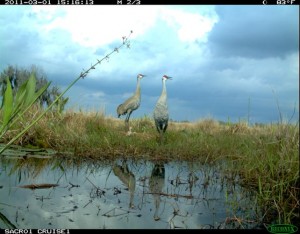
Also significant at this nest was the fact they were also incubating a data-logging egg that we had placed in their nest. The data recorded will provide a “known successful” recipe for incubation temperature.
Camera traps also documented water levels. This is important because too much water can flood nests and too little water will cause abandonment. One nest was unique in that the nest was constructed of mud and sticks on a natural rise in an otherwise open-water pond. Extremes in water level can be seen at this nest in the next picture.
Camera traps captured important bird behaviors. Last year we discovered from data-logging eggs that whooping cranes were sometimes leaving their nests unattended at night. This quarter we deployed the first-ever successful camera trap at a whooping crane nest.
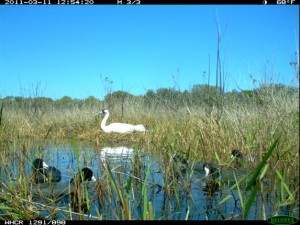
Important was the documentation of the pair exchanging incubation duties in the dark.
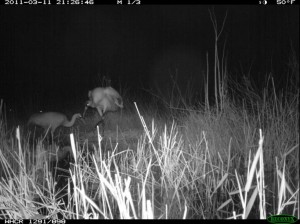
Of the trailcam photos from sandhill nests we reviewed thus far there have been no obvious nest exchanges at night. This could be a fundamental behavioral difference between the 2 species that previously has been undescribed (but we’ll need data from more whooping crane nests before we can say that). Or, it could be a behavioral artifact of captive rearing for the whooping cranes. Whatever the reason, it would seem to add vulnerability to the eggs and potentially attract attention to the nests of whooping cranes.
We ended the 2011 nesting season with data from 22 sandhill crane nests and 7 whooping crane nests. The results are still preliminary, but it is evident that these new techniques for studying nest success are providing exciting and valuable information about crane reproduction. We plan to continue the study next year to get more data, especially from whooping crane nests. This work was funded in part by the U.S.Fish and Wildlife Service.
Marty Folk, Florida Fish and Wildlife Conservation Commission.
Ultralight led arrivals
December 16, 2010Ultralight-led Whooping Cranes Arrive at First Wintering Destination in Florida
December 16, 2010
 Five endangered whooping cranes and their surrogate parents, three ultralight aircraft, arrived yesterday at their wintering grounds in Florida after a trek of more than 1,000 miles through seven states.
Five endangered whooping cranes and their surrogate parents, three ultralight aircraft, arrived yesterday at their wintering grounds in Florida after a trek of more than 1,000 miles through seven states.
Five of the 10 “Class of 2010” ultralight-led cranes arrived yesterday at the St. Marks National Wildlife Refuge (NWR) in Wakulla County, Florida. The other five ultralight-led whooping cranes will continue to their final destination at the Chassahowitzka NWR in Citrus County, Florida.
These 10 cranes are the 10th group to be guided by ultralights to Florida from Necedah NWR in central Wisconsin. The Whooping Crane Eastern Partnership (WCEP), an international coalition of public and private organizations, is conducting the reintroduction project in an effort to restore this endangered species to part of its historic range in eastern North America.
“St. Marks has been anticipating the birds’ arrival for months, and the outpouring of community support around Wakulla and Leon counties has been phenomenal,” said Terry Peacock, Refuge Manager at St. Marks NWR. “We are thankful for the help of all of our volunteers who have assisted with preparations around the refuge.”
In addition to the 10 birds led south by project partner Operation Migration’s ultralights, 10 cranes are making their first southward migration as part of WCEP’s Direct Autumn Release (DAR) program.
Biologists from the International Crane Foundation and the U.S. Fish and Wildlife Service reared the cranes at Necedah NWR and released them in the company of older cranes from whom the young birds will learn the migration route. The DAR and ultralight-led chicks this year are joining two wild-hatched chicks in the 2010 cohort.
Whooping cranes that take part in the ultralight and DAR reintroductions are hatched at the U.S. Geological Survey’s Patuxent Wildlife Research Center in Laurel, Md., and at the International Crane Foundation in Baraboo, Wis. Chicks are raised under a strict isolation protocol and to ensure the birds remain wild, handlers adhere to a no-talking rule and wear costumes designed to mask the human form.
In 2001, Operation Migration’s pilots led the first whooping crane chicks, conditioned to follow their ultralight aircraft surrogates, south from Necedah NWR to Chassahowitzka NWR in Florida. Each subsequent year, WCEP biologists and pilots have conditioned and guided additional groups of juvenile cranes to Florida. Having been shown the way once, the young birds initiate their return migration in the spring, and in subsequent years, continue to migrate on their own. In 2008, St. Marks NWR along Florida’s Gulf Coast was added as an additional wintering site for the juvenile cranes.
In the spring and fall, project staff from the International Crane Foundation and the U.S. Fish and Wildlife Service track and monitor the released cranes in an effort to learn as much as possible about their unassisted journeys and the habitat choices they make both along the way and on their summering and wintering grounds.
Most of the whooping cranes released in previous years spend the summer in central Wisconsin, where they use areas on or near Necedah NWR, as well as other public and private lands.
Whooping cranes were on the verge of extinction in the 1940s. Today, there are only about 570 birds in existence, approximately 400 of them in the wild. Aside from the 114 WCEP birds, the only other migrating population of whooping cranes nests at Wood Buffalo National Park in northern Alberta, Canada and winters at Aransas NWR on the Texas Gulf Coast. A non-migrating flock of approximately 20 birds lives year-round in the central Florida Kissimmee region.
Whooping cranes, named for their loud and penetrating unison calls, live and breed in wetland areas, where they feed on crabs, clams, frogs and aquatic plants. They are distinctive animals, standing five feet tall, with white bodies, black wing tips and red crowns on their heads.
WCEP asks anyone who encounters a whooping crane in the wild to please give them the respect and distance they need. Do not approach birds on foot within 200 yards; remain in your vehicle; do not approach in a vehicle within 100 yards. Also, please remain concealed and do not speak loudly enough that the birds can hear you. Finally, do not trespass on private property in an attempt to view or photograph whooping cranes.
Whooping Crane Recovery Update
October 5, 2010October 2009 to September 2010
Highlights:
The Aransas-Wood Buffalo population (AWBP) of whooping cranes rebounded from 247 present in the spring of 2009 to 263 in the spring, 2010. With 46 chicks fledging from a record 74 nests in August, 2010 the flock size should reach record levels this fall expected somewhere around 290. Threats to the flock including land and water development in Texas, the spread of black mangrove on the wintering grounds, the long-term decline of blue crab populations in Texas, sea level rise / land subsidence, and wind farm and power line construction in the migration corridor all continued to be important issues.
Two whooping cranes captured at Aransas and nine in Wood Buffalo National Park (WBNP) were fitted with GPS transmitters and tracked by satellite. Crews visited migration stopover sites after the birds were present to gather habitat use data. This project is being carried out by The Crane Trust headed up by Dr. Felipe Chavez-Ramirez. It is funded by the Platte River Recovery Implementation Program, The Crane Trust, and the USGS Northern Prairie Wildlife Research Center. The tracking is the first done on the AWBP in 25 years and is a top research priority of the Whooping Crane Recovery Team! Since the 1950s, 474 AWBP whooping cranes have died, with 37 carcasses recovered, and cause of death determined in only 17 instances. With the loss of 21.4% of the flock in the 12 months following April 2008, it is imperative that we learn more about whooping crane mortality.
Based on opportunistic sightings, the Cooperative Whooping Crane Tracking Project documented 103 confirmed sightings of whooping cranes in the U.S. Central Flyway during fall, 2009 and 52 sightings in spring, 2010.
A study by Dr. Ken Jones at the University of Georgia genomics lab to better describe the genetic composition of the captive flock got underway in September, 2010. The new genomics technology will derive genetic information from 454 single nucleotide polymorphisms, a substantial increase from the 12 loci used in the past on which most of our genetic decisions involving whooping crane pairings are currently based.
Planning efforts continued for the proposed reintroduction of a nonmigratory flock of whooping cranes at White Lake, Louisiana. White Lake is where the last whooping crane nest in Louisiana had been found in 1939.
Production in the wild from reintroduced flocks in 2010 was somewhat disappointing, though better than last year. In Florida with improved water conditions, 8 of the 9 remaining pairs nested and hatched 4 chicks, but only 1 chick survived to fledge. In Wisconsin, 12 pairs nested, with 3 first nests and 3 re-nests incubated full term and hatching 7 chicks. Two chicks fledged. Nest abandonment consistent with the presence of black flies continued to be a major hurdle for the reintroduction at Necedah National Wildlife Refuge (NWR).
The captive flocks had a very good production season in 2010. Twenty-four chicks entered the migratory reintroduction program in Wisconsin, and 11 chicks are being formed into a cohort for a possible nonmigratory release in Louisiana in February, 2011. Three chicks of high genetic value were held back for the captive flocks.
Flock sizes are estimated at 263 for the AWBP, 119 for the WI to FL flock, and 25 nonmigratory birds in Florida. With 167 cranes in captivity, the world total (all located in North America) of whooping cranes is 574, up 38 from one year ago.
The full report can be read here…
Whooping Crane Recovery Update: October 2009 to September 2010
Support the Whooping Cranes Web
Are you interested in books about cranes or other related topics? If you are, use the link below to search for your favorite subject.
All books ordered through this link to Amazon will result in a small commission being paid to the Whooping Crane Conservation Association and any money received will be used to help pay for operation of this web page.
Thank you for your support.
This web site is maintained by Business Cornerstone Services
NEWS FLASH! Record set for this flock
May 19, 2010Tim Dellinger checked one of our Florida whooping crane families from the air today (they are not visible from the ground) and discovered they have 2 chicks instead of 1 (as seen on the previous flight). Raising 2 chicks to 15 days of age is a record for this flock. Until now a pair had only raised both of their chicks up to 12 days of age before losing one. This is this pair’s first nest attempt. They will turn 7 years of age next month.
–Marty Folk
UPDATE 4 – Florida Resident non-migratory Flock of Whooping Cranes
May 17, 2010May 17, 2010
Marty Folk, Avian Research, Florida Fish and Wildlife Conservation Commission reports that , “All 9 whooping crane nests have now either hatched (3) or failed (6). We will monitor the 3 chicks that hatched. Another nest or a re-nest is possible for another week or 2. We will continue to study nesting sandhill cranes until we run out of nests. Then we will begin looking at the behavioral and nest temperature data.
WCCA is pleased to pass on Marty’s important reports.
UPDATE 3 – Florida Resident non-migratory Flock of Whooping Cranes
May 10, 2010May 10, 2010
Marty Folk, Avian Research, Florida Fish and Wildlife Conservation Commission reports that. “Of this spring’s 9 nests, thus far 3 chicks have hatched in 3 nests. Two pairs hatched a chick for the first time. Both members of one pair are 7 years old. The female of another “first-time hatching pair” turns 17 years old on Thursday. Her mate is 10 years old. Talk about your late-bloomers!
Four nests failed (1 to alligator predation and 3 for unknown reasons) and 2 are still being incubated. We continue to collect behavioral and nest temperature data at 2 whooper nests and 1 sandhill crane nest.
UPDATE 2 – Florida Non-Migratory Whooping Crane Flock
April 24, 2010April 20, 2010
Marty Folk, Avian Research, Florida Fish and Wildlife Conservation Commission sent the Whooping Crane Conservation Association the latest happenings on the non-migratory whooping crane flock in Florida.
Marty reported:
Since my last update the following has occurred:
Lake County re-nest: This pair has just hatched a chick and may be incubating a 2nd egg.
Lake Okeechobee nest: failed for unknown reasons. Pair left that area.
Lake County nest 2: We continue to collect behavioral and temperature data from this nest.
Lake County nest 3: We are collecting behavioral and temperature data from this nest.
Polk County: A nest was discovered 8 April. Equipment not available for behavioral/temperature study.
Osceola County: A nest was discovered 12 April. We are collecting behavioral and temperature data from this nest.
Alachua County: A nest was discovered 12 April. Nest too remote for behavioral/temperature study.
The total nests this year is 9, with 6 currently active.
One pair showed promise for nesting-had been observed building a nest platform. However, the 10-year-old female was recovered from under a power line and collision with the line is the presumed cause of death. At necropsy she was found to be carrying 2 eggs.
UPDATE – 1 Non-Migratory Whooping Crane Flock in Florida
April 5, 2010Monday, April 05, 2010
Marty Folk, Avian Research, Florida Fish and Wildlife Conservation Commission reports that, “We continue to study the non-migratory flock of whooping cranes in Florida. This is the first report I’m sending out for our 2010 Breeding Season. Please share this within your respective organizations and with other professional associates that might be interested.”
Marty explains, “We entered the 2010 breeding season with 26 birds (10M:16F), 10 pairs. Marsh water levels are the best we’ve seen since 2006. To enhance our knowledge of reproductive biology we have been collecting, since last fall, behavioral observations on frequency of copulations. Also, this spring, in addition to continuing our video surveillance of nests to document incubation behavior, we are conducting a “pilot” study of measuring the temperature within crane nests via artificial data-logging eggs. Partners for this study include Billy Brooks of the USFWS (provided data loggers), Donna Bear-Hull of the Jacksonville Zoo (her team constructed the eggs), and Marilyn Spalding of the University of Florida (necropsy and tissue salvage from collected eggs). My agency (FWC) provided transmitters to go inside the artificial eggs to allow tracking of any “wayward” eggs that might disappear from nests. I don’t have room here to go into detail regarding the egg construction and deployment protocols, but let me summarize it to say that single egg clutches are simply supplemented with an artificial data-logging egg. For 2 egg clutches we remove a natural egg and leave the data-logging one. Natural eggs collected from the wild are humanely killed and if fertile, tissues used for IBD research. We are collecting concurrent data on behavior (gathered via video surveillance) and nest microclimate (from the data-loggers) from nests of whooping and Florida sandhill cranes. Results from this work may allow us to:
1) compare, contrast, and describe basic behavioral biology of nesting whooping and sandhill cranes
2) determine if there are behavioral reasons why some whooping cranes are unsuccessful at hatching eggs in Florida
3) make recommendations to captive facilities on how to adjust incubators to improve hatching success
4) provide baseline data for successful incubation behavior that can be used for comparisons with other reintroduced flocks of cranes.”
Several groups have done some work with data-logging eggs with nesting captive cranes (George Gee et al., Calgary Zoo), but to my knowledge no-one has done this with wild crane nests. The Florida flock of whooping cranes presents a unique research opportunity. The chances of this flock becoming self-sustaining are low, and there are no plans for further releases. However, the flock is available for study and experimental manipulation at a level that has not yet been conducted with other crane flocks.
————————-
Marty continues, “It has been an interesting breeding season. Thus far 6 whooper nests have been initiated. The first nest (Lake County) failed when the pair abandoned their nest for unknown reasons. We do not suspect it was in response to the deployment of the data-logging egg because they didn’t abandon their nest until several days after deployment of the egg. This pair re-nested and currently are actively tending their nest.
Another nest was initiated in Osceola County. This nest failed within the range of dates for “expected hatching”. Early in incubation we had deployed an artificial egg into the nest. Upon visiting the failed nest, the artificial egg was found in several pieces and there were teeth marks in the pieces. The teeth marks were similar in appearance to those seen when alligators have chewed on transmitters. Despite this, the egg transmitter and datalogger were successfully recovered from the floor of the marsh. The natural egg was missing. The nesting pair was not tending the nest and the female was found to be missing an entire leg (there were no blood stains on the bird, simply no leg visible below the feathers. Fortunately it was not the transmittered leg that was missing). The bird was flight capable and wary. The quality of the surveillance video for this nest was very marginal due to the distance between the camera and nest, however, it did show that the evening (several hours before sunset) prior to the discovery of the failed nest, one bird struggled near the nest while the other stood on the nest with outspread wings. Apparently an alligator caught the bird in “broad daylight”. The night after this discovery (the female’s 2nd night as a one-legged crane), she was taken by a bobcat. This was a 10 year-old female.
Another nest in a vast marshy area of Lake Okeechobee came as quite a surprise because the “pair” consisted of 2 females. The older bird had nested previously with a male, but now she was with a wild-hatched bird that had been identified via blood sample as a female. Of course there can be “errors” in the identification of gender. When this pair moves to an accessible/assessable location we will observe them for behavioral clues as to gender. They currently are in a remote area 5 miles from the nearest uplands. (Monitoring has been from the air).
The next nest was initiated in Lake County. The male of this pair last nested in 2006 with a different female in the same marsh. 2006 was the last time, until now, that the marsh had water. This spring’s nest, 4 years later, is within 80 m of where the 2006 nest was. We are collecting behavioral and temperature data from this nest.
A new nest was discovered just now in Lake County. Two other whooper pairs have been observed doing some nest-building so we may have more whooper nests to study in the near future.
In addition to the whooper nests above, we have collected behavioral data at one Florida sandhill crane nest. We plan to collect behavioral and temperature data at one or more additional sandhill crane nests yet this season.
